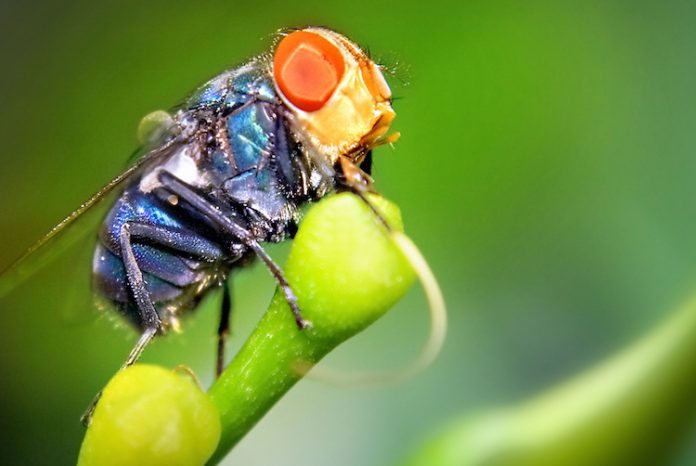
Studies in fruit flies have shown how cells in the offspring of older fathers can replace copies of genes that have been lost due to aging. The findings by Yukiko Yamashita, Ph.D., a Howard Hughes Medical Institute investigator, and colleagues at the University of Michigan Life Sciences Institute provide clues as to how some cells could overcome genomic shrinkage that appears to occur as an organism ages. If the same results can be confirmed in humans, they could offer a new level of understanding about how cells deteriorate with time.
These findings are reported in eLife, in a paper entitled “Transgenerational Dynamics of rDNA Copy Number in Drosophila“ Yamashita’s team looked specifically at ribosomal DNA (rDNA) loci that contain the genes for ribosomal RNA (rRNA). These loci are repeated at multiple sites on different chromosomes. For example, five human chromosomes contain regions in which rDNA genes are repeated hundreds of times. However, as the authors explain, rDNA is very unstable. “rDNA loci, composed of hundreds of tandemly duplicated arrays of rRNA genes, are known to be among the most unstable genetic elements due to their repetitive nature.” And with repeated cell divisions, some copies of the rDNA genes are lost. “The end result is that some copies are lost every cycle,” Yamashita says. “They are popping out of the chromosome.”
Studies have confirmed that in yeast cells, at least, this rDNA instability and gene copy loss underlies aging, via a process known as replicative senescence. What isn’t yet known, however, is whether rDNA instability contributes to aging in multicellular organisms. To investigate this further, the researchers turned to the fruit fly, Drosophila melanogaster. Their studies looks more closely at the dynamics of rDNA loci and rDNA loss during aging in male Drosophila germline stem cells (GSCs), which continue to divide throughout adulthood. In the fruit fly, the rDNA loci are found only on the X and Y sex chromosomes, so studying rDNA stability in this organism is easier than it would be in organisms that have rDNA loci spread across many chromosomes.
The results of their cell analyses showed that in comparison with younger male fruit flies, older males had fewer copies of the rDNA genes on the Y chromosome in their GSCs—in effect their Y chromosomes had shrunk. These older fathers then passed the reduced amount of rDNA on to their male offspring.
However, rather make do with fewer rDNA genes, the offspring were able to rebuild the number of rDNA copies in the Y chromosomes of their GSCs. By the time they had reached about 10 days of age, the sons of aged fathers had comparable amounts of rDNA to those male offspring of younger fathers that had passed on less depleted Y chromosomal rDNA. “Strikingly, we found that GSCs in the F1 generation are capable of recovering rDNA copy number in the early ages of adulthood, revealing the likely presence of a mechanism that maintains rDNA copy number through generations,” the authors write. “This recovery was something we really didn't expect,” Yamashita acknowledges.
Interestingly, recovery of of rDNA copy number was limited to young adults, suggesting that the mechanisms at work might only occur under certain conditions. “It remains unclear if such conditions are developmentally programmed or reflect the limitation of certain cell biological processes that underlie rDNA copy number recovery,” the authors point out. The results do indicate that rejuvenation of rDNA in sons plays a key role in the persistence of stem cells from father to son. What isn’t known yet is whether the same rebuilding of lost rDNA can also occur in female stem cells in the ovary.
Further analysis indicated that the process of rDNA copy number recovery uses the same factors that are needed for a phenomenon known as rDNA magnification, in which DNA copy number is rapidly expanded in the male germline of animals that are deficient in rDNA due to large rDNA deletions. “Our study also indicates that the phenomenon classically regarded as ‘rDNA magnification’ might be a manifestation of a general ‘maintenance’ mechanism that operates in the population that experiences normal fluctuations in rDNA copy number,” the researchers suggest.
It might be “logically deduced” that rDNA copy number can’t continue to decrease from generation to generation without an eventual complete collapse, they also note. Nevertheless, the team claims that the Drosophila studies are “the first to show that rDNA copy number is indeed actively maintained through generations.”
Yamashita suspects that mechanisms allowing cells to reset gene copy number may also be present in some types of human cells, but this has yet to be demonstrated. Nevertheless, new findings about how specific cells can rejuvenate “touches upon the secret of germ cells’ immortality.”











